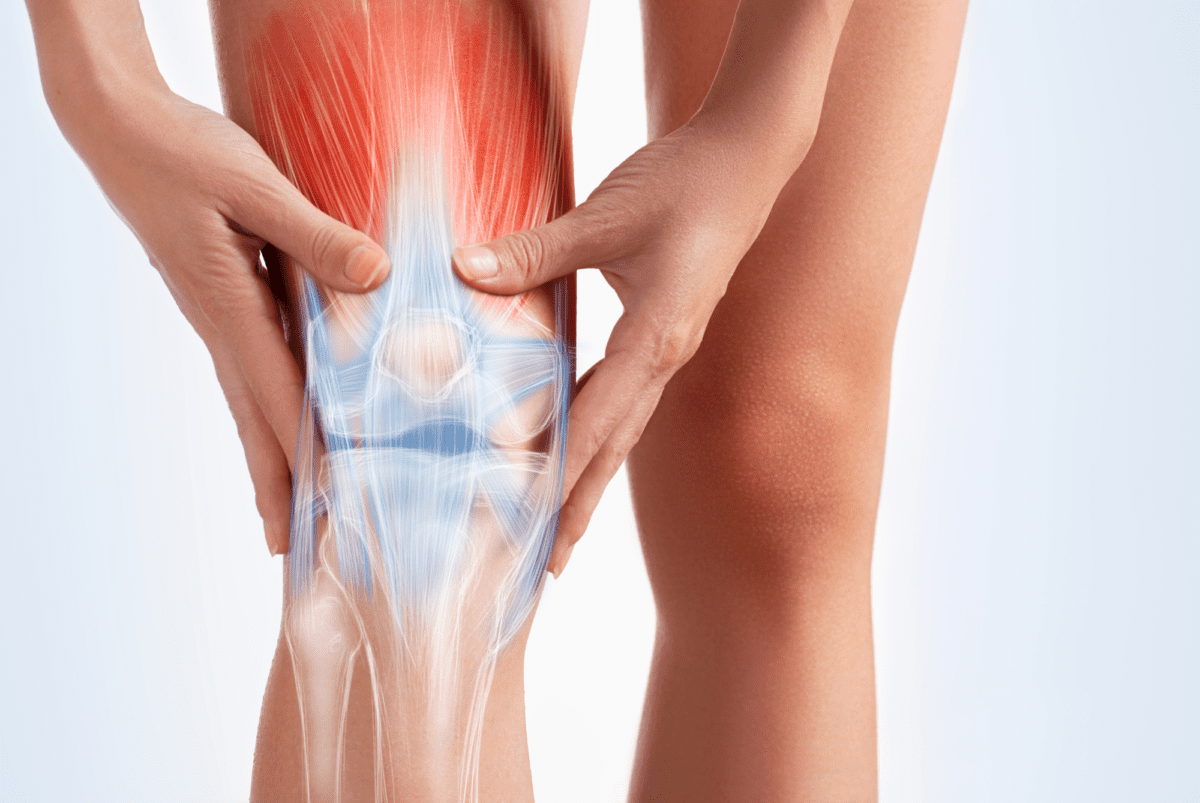Knee osteoarthritis: Your questions answered

Osteoarthritis is a condition in which the cartilage between joints wears away. Without this natural cushioning between the bones, they begin to rub together causing pain, swelling, and stiffness.
Osteoarthritis most commonly affects the largest joint in the human body – the knee. The healing ability of the knee cartilage decreases with age, leading to knee osteoarthritis.
The condition can make daily life difficult as a result of continued pain and discomfort. Understanding your osteoarthritis can help provide relief through awareness and treatment.
To help you on your journey with knee osteoarthritis, our experienced exercise physiologists have answered your frequently asked questions.
What is knee osteoarthritis?
Knee osteoarthritis is a condition in which the shock-absorbing cartilage between the thigh bone, kneecap, and shinbone gradually wears away. Without this cartilage to provide lubrication as the joint moves, the bones begin to rub together. This friction can cause pain, swelling and reduced range of motion in the knee.
Osteoarthritis of the knee is the most common form of osteoarthritis. Unfortunately, there is no cure for the degenerative joint disease, although treatment can help relieve pain and improve mobility.
What causes osteoarthritis of the knee?
The most common cause of osteoarthritis of the knee is age. Once cartilage is lost, it can’t be regenerated, and as we age our healing ability reduces. For this reason, osteoarthritis is particularly common among retirees.
Certain genetic and lifestyle factors can increase the risk of developing osteoarthritis in the knee. These include:
- Genetics – those with a family history of osteoarthritis are more likely to develop the condition themselves. Genetics can also influence the structure of the knee joint. This can lead to developing osteoarthritis earlier.
- Gender – women are more likely to develop osteoarthritis than men, particularly after age 55. This is a result of menopause and its direct impact on bone density. Women over 65 are twice as likely as men to experience osteoarthritis symptoms.
- Weight – the knee is a weight-bearing joint. The more weight applied to it, the more stress it is under and the quicker the deterioration of cartilage.
- Physical activity – although regular exercise can help strengthen joints, sports that place the knee joint under repeated stress can be a risk factor for developing osteoarthritis. This can include soccer, long-distance running, and weight lifting.
Existing condition – a prior knee injury or existing condition, such as rheumatoid arthritis, leaves an individual more vulnerable to osteoarthritis in the knee.
What are osteoarthritis of the knee symptoms?
Osteoarthritis of the knee symptoms will typically come on gradually and worsen with time. Persistent pain, joint stiffness and reduced mobility are the most common indications osteoarthritis may be present in the knee.
The friction between the three bones in the joint can cause inflammation and swelling. It is often knee osteoarthritis swelling that then leads to a reduction of movement in the joint.
Other knee osteoarthritis symptoms can include:
- A warm or hot feeling in the joint
- Stiffness in the knee – particularly first thing in the morning or after extended periods of inactivity
- Decreased mobility of the knee – demonstrated by difficulty getting in and out of chairs, using the stairs, or walking
- A creaking or crackly sound coming from the knee when it moves
The condition can be uncomfortable and at times debilitating. Fortunately, symptoms may not always be present, with pain typically worsening with exercise, but easing with rest. A qualified exercise physiologist or physiotherapist can help prescribe a management plan that alleviates symptoms and allows you to enjoy your daily life.
Can osteoarthritis of the knee be prevented?
It’s important to recognise that osteoarthritis of the knee is not an inevitable consequence of ageing. Certain proactive practices may help reduce your risk of developing the condition or prolong its onset.
Examples of preventative exercises for knee osteoarthritis include:
- Low weight-bearing exercises such as swimming and cycling. These movements allow the knee joint to retain healthy movement without placing it under stress.
- Prevent knee injury via a prehabilitation program.
- Maintain a healthy weight
How is knee osteoarthritis diagnosed?
A doctor will perform a series of tests to determine if a patient is suffering from osteoarthritis of the knee. Ongoing pain and swelling in the knee will typically be the first reason a patient presents to a doctor for testing.
From here, the doctor will review symptoms and perform a physical examination. The patient may also be referred for X-rays and lab tests. Once an accurate diagnosis has occurred you may be referred to an exercise physiologist or seek one on your own.
Your exercise physiologist will complete an initial consult and create a care pathway to ensure adequate treatment and management of the condition.
What is osteoarthritis of the knee treatment?
There are strategies specifically designed to reduce the impact of knee osteoarthritis on the quality of life, and in the early stages, good management can be highly beneficial. Early detection and treatment can help to reduce patients’ pain, preserve function and slow disease progression.
An exercise physiologist or physiotherapist can help develop a specialised treatment plan. It’s important to remember that the primary goal of a care plan is not to cure the disease but to ease pain and discomfort while returning movement to the knee.
Osteoarthritis of the knee treatment can include one or a combination of the following:
- Physical therapy – knee osteoarthritis exercises designed to strengthen muscles around the joint and restore movement
- Medical – pain and anti-inflammatory medications can help provide temporary relief for knee osteoarthritis symptoms
- Remedial – alternative treatments such as topical creams, hot cold compresses, and acupuncture may help manage symptoms
- Bracing – using either ‘unloader’ braces (take the weight away from the affected part of the knee) or ‘support’ braces (support the entire knee) to ease the burden on the knee joint
- Surgery – typically the last resort, surgery is reserved for cases when non-surgical treatments have been ineffective
What are osteoarthritis of the knee exercises?
Exercise physiologists and physiotherapists are specialised in the management of osteoarthritis symptoms. They can provide a personalised care plan that addresses the underlying cause of the condition while working towards a specific goal – such as pain management or movement improvement.
In most cases, this care plan will centre on knee strengthening exercises for osteoarthritis. Stronger muscles around the knee provide several benefits to patients, including:
- Helping to cushion, support and protect the joint
- Making it easier to perform daily activities, such as walking or standing from sitting
- Correcting movement patterns of the knee joint
Beginning the exercise journey under supervision can help ensure movements are being performed correctly and effectively. Knee osteoarthritis exercises for older adults should be undertaken with particular care.
Strength training does not have to require heavy load bearing. It may be a series of bodyweight exercises targeted at the muscles surrounding the knee – such as the quads, hamstrings, glutes and calves.
Common examples include:
- Glute bridges
- Leg extensions
- Calf raises
- Standing to sitting movements
Other alternatives include low-weight-bearing exercises such as swimming, cycling, water aerobics and tai chi. When performed regularly these exercises have proven beneficial for retirees suffering from knee osteoarthritis.
Where to get treatment for knee osteoarthritis
A healthcare provider can assess a patient for osteoarthritis and provide a diagnosis. An ongoing care provider can then offer physical therapy and exercises for knee osteoarthritis to help manage the condition.
Atkins Health has a specialised team of physiotherapists and exercise physiologists experienced in the treatment of knee osteoarthritis. Our caring professionals have a deep understanding of the toll the condition can take on a patient’s overall well-being. Our treatment plans are deeply personalised to help every individual get back on their feet and enjoy life as soon as possible.
Get in touch to find out we can help alleviate your knee osteoarthritis troubles.


